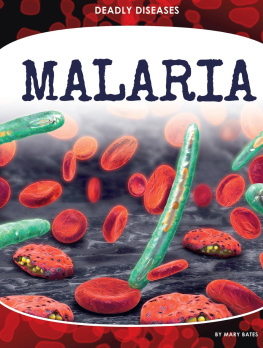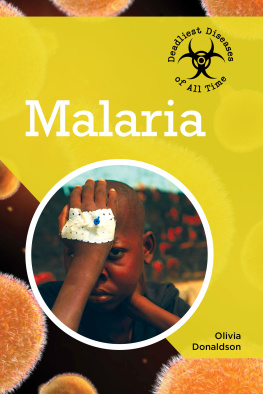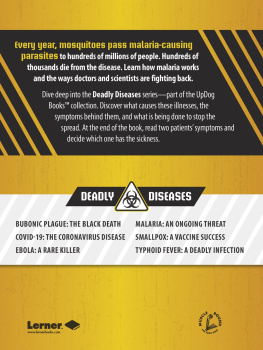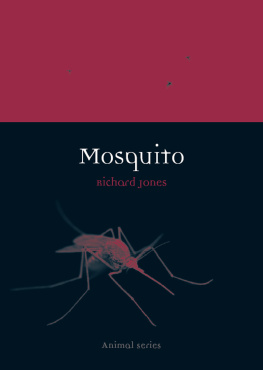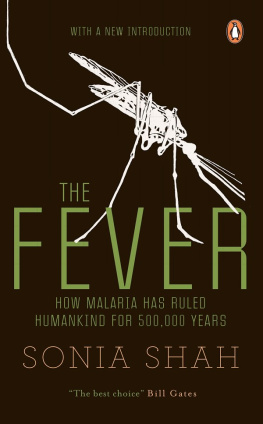Contents
Guide
Page List
DEADLY DISEASES
MALARIA
BY MARY BATES
CONTENT CONSULTANT
Samarchith P. Kurup, DVM, PhD, Assistant Professor
Center for Tropical and Emerging Global Diseases &
Department of Cellular Biology, University of Georgia
Core Library
Cover image: Malaria parasites attack red blood cells inside
An Imprint of Abdo Publishing
the body.
abdobooks.com
abdobooks.com
Published by Abdo Publishing, a division of ABDO, PO Box 398166, Minneapolis, Minnesota 55439.
Copyright 2022 by Abdo Consulting Group, Inc. International copyrights reserved in all countries.
No part of this book may be reproduced in any form without written permission from the publisher.
Core Library is a trademark and logo of Abdo Publishing.
Printed in the United States of America, North Mankato, Minnesota.
102021
012022
Cover Photo: Christoph Burgstedt/Shutterstock Images
Interior Photos: Isaac Kasamani/AFP/Getty Images, 45; Shutterstock Images, 6, 20; Kateryna Kon/
Shutterstock Images, 8; Red Line Editorial, 10, 38; Andreas Wolochow/Shutterstock Images, 1213;
National Library of Medicine/Science Source, 15; Sheila Terry/Science Source, 16; Bettmann/Getty
Images, 18; Wellcome Images/Science Source, 2223; Science Picture Co/Science Source, 24, 43;
Christoph Burgstedt/Science Source, 27, 45; Ricardo Moraes/AP Images, 28; Haroub Hussein/AP
Images, 3031; Ton Koene/picture-alliance/dpa/AP Images, 33; Muhammed Muheisen/AP Images,
34; Mark Schiefelbein/AP Images, 36; Riccardo Mayer/Shutterstock Images, 40
Editor: Arnold Ringstad
Series Designer: Ryan Gale
Library of Congress Control Number: 2021941216
Publishers Cataloging-in-Publication Data
Names: Bates, Mary, author.
Title: Malaria / by Mary Bates
Description: Minneapolis, Minnesota : Abdo Publishing, 2022 | Series: Deadly diseases | Includes
online resources and index.
Identifiers: ISBN 9781532196607 (lib. bdg.) | ISBN 9781098218416 (ebook)
Subjects: LCSH: Malaria--Juvenile literature. | Malaria--Prevention--Juvenile literature. | Infectious
diseases--Juvenile literature. | Epidemics--History--Juvenile literature. | Communicable
diseases--Epidemiology--Juvenile literature.
Classification: DDC 614.49--dc23
CONTENTS
CHAPTER
ONE
MALARIA AND
MOSQUITOES
oan Nalubega is an entrepreneur
in Uganda. When she was a young
J
girl, she lived at an orphanage. She
caught malaria frequently. This disease is
common in Uganda and nearby countries. It is
spread by mosquitoes. Malaria causes fevers
and aches. It can be deadly. Nalubega was
bullied as a child for being sick so often.
Since childhood, Nalubega wanted to stop
malaria. Even at the orphanage, Nalubega
started to think of ways to fight the disease.
One idea was to hold up a mosquito net with a
Joan Nalubega has found a new way to fight
malaria in Uganda.
Mosquito nets are
important tools in
defending against
mosquitoes that
spread disease.
stick. Then the person could walk around under the net.
But this wasnt a practical idea. Mosquito nets are great
for protecting people while they are sleeping. However,
there isnt an easy way to use them during the day.
People had been using the same things to fight
malaria for decades. This included mosquito nets. But
sometimes they still caught malaria during the day.
Some people gave up on malaria prevention.
In 2016, Nalubega had an idea to change that. She
started a company to make mosquito repellant soap.
Soap is a product people use every day. One issue with
mosquito sprays is the bad smell. Nalubega made the
soap smell good. She also made it cheap to buy. This
meant more people could use it. Nalubega is one of
many people finding new ways to battle malaria today.
PROBLEMATIC PARASITES
Malaria is a serious disease caused by parasites.
A parasite is a creature that uses another creature to
survive. The creature it uses is called a host. Parasites
harm the host to keep themselves alive.
The parasite that
causes malaria lives in
LETHAL LADIES
Malaria is spread only
blood. It can spread
through the bites of female
through the bites of
mosquitoes. Male mosquitoes
infected mosquitoes.
do not bite. Instead, they
feed on nectar and other
Only some mosquitoes
sugars. Blood gives female
can transmit malaria.
mosquitoes the nutrients they
need to make eggs.
They belong to the
group Anopheles .
Malaria parasites enter blood cells to reproduce.
An Anopheles mosquito bites a person with malaria. It
eats blood containing the parasites. Then the mosquito
bites another person. The parasites enter the blood of
that person.
A GLOBAL
THREAT
Malaria occurs in most
PERSPECTIVES
warm regions of the
PREVENTING
world. Anopheles
MALARIA
Malaria deaths fell 44 percent
mosquitoes live in
from 2010 to 2019. Still, the
places with warm
disease remains a leading
cause of death in some
temperatures. They
regions. Estrella Lasry is the
are common in parts
tropical diseases adviser at
Doctors Without Borders. This
of Africa. They are also
international organization
found in South Asia,
provides medical aid where
it is needed most. Lasry says
Central and South
prevention is key to fighting
America, and the
malaria. She explains that
Middle East.
if these efforts slow down,
populations will continue to
About half of the
suffer and die from malaria.
And the world may end up
worlds population
seeing a malaria resurgence,
is at risk of malaria.
endangering the huge
successes of this millennium.
The danger is
especially high for
people who live in
MALARIA
TRANSMISSION
This map shows the parts of the world where malaria is found.
What do you notice about these regions? What do areas where
people contract malaria have in common?
N
W
E
S
Some malaria transmission
Widespread malaria transmission
lower-income countries. Travelers to these warm regions
are also at risk.
The world has made a lot of progress in controlling
malaria. Still, it remains a major public health problem.
The World Health Organization (WHO) estimates that
there were 229 million cases of malaria in 2019. Of
these, about 409,000 people lost their lives. Finding
new ways to prevent and treat malaria can help reduce
these numbers.
EXPLORE ONLINE
discusses where most cases of malaria occur.

